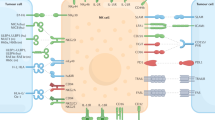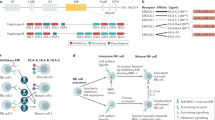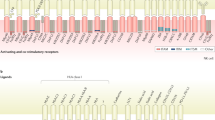Abstract
A class of cytotoxic effector cells has recently been discovered1,2 in normal and immunodeficient nude mice that lyse a wide range of targets of both tumour and non-tumour origin. Unlike other lymphocytes, these natural killer (NK) cells are present at high levels without prior priming and have no immunological memory. Because NK cells act without prior sensitization, they could have a crucial role in immunosurveillance, providing a first defence against arising neoplastic cells. The question of NK-cell specificity is not well understood; results so far suggest that they may recognize specific antigens on their targets. Thus unlabelled competitor cells can inhibit the cytotoxic reaction of NK cells3. Furthermore, target–effector binding can be inhibited by isolated target structures4. Experiments in which the lysis of mouse and human NK-sensitive targets was competitively inhibited with target suggested that the targets recognized by NK cells are not common ones. To study this important aspect, permanent lines and clones of NK cells have been established in vitro. I report here a successful attempt to do this, and show that sublines display the same specificity spectrum as NK cells from normal cells even after recloning. This proves that antigen receptors on NK cells are not clonally distributed but leaves open the two possibilities that NK cells either recognize common structures on NK-sensitive targets or carry many receptors each with a different specificity. Cell-surface markers of NK lines distinguished them from allospecific thymus-derived lymphocyte cell lines through their lack of Lyt-1 and Lyt-2 antigen.
This is a preview of subscription content, access via your institution
Access options
Subscribe to this journal
Receive 51 print issues and online access
$199.00 per year
only $3.90 per issue
Buy this article
- Purchase on Springer Link
- Instant access to full article PDF
Prices may be subject to local taxes which are calculated during checkout
Similar content being viewed by others
References
Roder, J. C. & Kiessling, R. Scand. J. Immun. 8, 135 (1978).
Herberman, R. B. & Holden, H. T. Adv. Cancer Res. 27, 305 (1978).
Kiessling, R., Klein, E. & Wigzell, H. Eur. J. Immun. 5, 112 (1975).
Roder, J. C., Rosèn, A., Fenyö, E. M. & Troy, F. A. Proc. natn. Acad. Sci. U.S.A. 76, 1405 (1979).
Rosenberg, S. A., Spiess, P. J. & Schwarz, S. J. Immun. 121, 1946 (1978).
Dennert, G. & Hyman, R. Eur. J. Immun. (in the press).
Dennert, G. & Hyman, R. Eur. J. Immun. 7, 251 (1979).
Herberman, R. B., Nunn, M. E. & Holden, H. T. J. Immun. 121, 304 (1978).
Mattes, M. J., Sharrow, S. O., Herberman, R. B. & Holden, H. T. J. Immun. 123, 2851 (1979).
Omary, B., Trowbridge, I. & Scheid, M. J. exp. Med. (in the press).
Dennert, G. Nature 277, 476 (1979).
Author information
Authors and Affiliations
Rights and permissions
About this article
Cite this article
Dennert, G. Cloned lines of natural killer cells. Nature 287, 47–49 (1980). https://doi.org/10.1038/287047a0
Received:
Accepted:
Issue Date:
DOI: https://doi.org/10.1038/287047a0
This article is cited by
-
Insufficient (Sub-native) Helix Content in Soluble/Solid Aggregates of Recombinant and Engineered Forms of IL-2 Throws Light on How Aggregated IL-2 is Biologically Active
The Protein Journal (2012)
-
Interleukin-2 in the treatment of HIV disease
Biotherapy (1990)
-
Expression of natural killer (NK) cell‐specific alloantigens on a mouse NK‐like cell line
Immunology & Cell Biology (1989)
-
T-cell receptor gene rearrangement and expression in human natural killer cells: natural killer activity is not dependent on the rearrangement and expression of T-cell receptor ?, ?, or ? genes
Immunogenetics (1988)
-
Interleukin 2 activity in peripheral blood mononuclear cells of patients with gynecologic malignancies
Medical Oncology and Tumor Pharmacotherapy (1988)
Comments
By submitting a comment you agree to abide by our Terms and Community Guidelines. If you find something abusive or that does not comply with our terms or guidelines please flag it as inappropriate.



